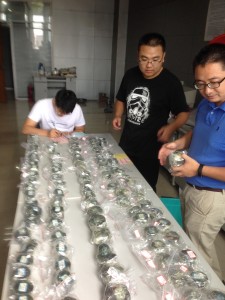The Hailaer Basin in Inner Mongolia, China has a lot of coal, mostly of Cretaceous age; some beds are over 40 m in thickness. Setting aside any of its economic uses, the scale of peat accumulation is phenomenal. The basin itself is tectonically dissected into coal fields ranging in size distribution from 20×80 km to 40×120 km (Guo et al., 2019; Zhang et al., 2018).
Even modest decompaction ratios would result in peat mires that were more than 100 m in thickness. What sort of depositional setting, climate and geochemistry would allow such thick peat to accumulate? Moreover, some of these Cretaceous paleo-peats have a lot of ‘inertinite’. The origin of inertinite can be from fire (thus fossil charcoal) (e.g. see Jones et al., 1991; Scott, 1989) fungal alteration (e.g. see Moore and Shearer, 1997; Moore et al., 1996) or possibly from aerial exposure.
Working with Professor Jian Shen of the School of Resources and Geoscience at China University of Mining and Technology, Xuzhou, China, myself and Dr Ofentse Moroeng of University of Johannesburg, South Africa sampled core from one of these thick Cretaceous coal seams. Dr Moroeng will look at the ∂13C and ∂N15 isotopes, which will help to determine the inertinite origin. I’ll do the organic petrology and Dr Shen will place all this within the geological context of the basin and region.
Guo, B., Shao, L., Hilton, J., Wang, S., Zhang, L., 2019. Sequence stratigraphic interpretation of peatland evolution in thick coal seams: Examples from Yimin Formation (Early Cretaceous), Hailaer Basin, China. International Journal of Coal Geology 196, 211-231.
Jones, T.P., Scott, A.C., Cope, M., 1991. Reflectance measurements and the temperature of formation of modern charcoals and implications for studies of fusain. Bulletin de la Société Géologique de France 162, 193-200.
Moore, T.A., Shearer, J.C., 1997. Evidence for aerobic degradation and implications for Palangka Raya peat sustainability, in: Rieley, J.O., Page, S.E. (Eds.), Biodiversity and Sustainability of Tropical Peatlands. Samara Publishing, Cardigan, United Kingdom, pp. 157-167.
Moore, T.A., Shearer, J.C., Miller, S.L., 1996. Fungal origin of oxidised plant material in the Palangkaraya peat deposit, Kalimantan Tengah, Indonesia: Implications for “inertinite” formation in coal. International Journal of Coal Geology 30, 1-23.
Scott, A.C., 1989. Observations on the nature and origin of fusain. Int. J. Coal Geol. 12, 443-475.
Zhang, Y., Shao, L., Sun, Q., Shi, M., Wang, S., Fan, J., Sun, B., 2018. Sequence-paleogeography and coal accumulation features of the Jiuqiao sag Yimin Formation in Hailaer Basin. Coal Science and Technology 46, 177-187.




Trackbacks/Pingbacks
[…] Previous blogs have also documented the early stages of this research (i.e.https://www.ciphercoal.com/something-wicked-this-way-comes-in-the-lower-cretaceous/, https://www.ciphercoal.com/not-freezing-in-inner-mongolia/, and https://www.ciphercoal.com/fire-and-brimstone-in-the-cretaceous/ […]